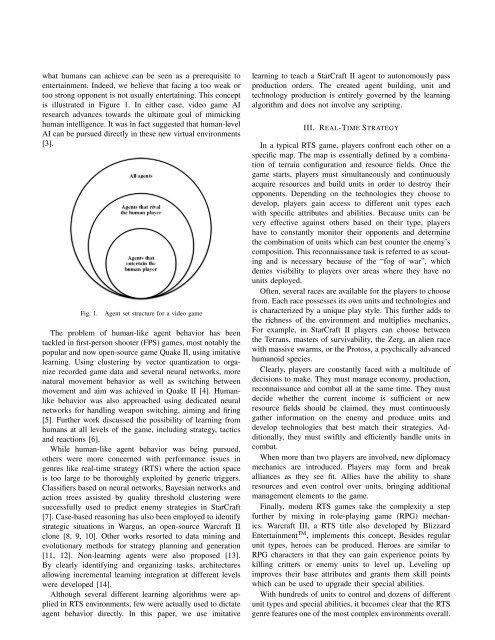Imitative Learning for Real-Time Strategy Games - Montefiore
Imitative Learning for Real-Time Strategy Games - Montefiore
Imitative Learning for Real-Time Strategy Games - Montefiore
You also want an ePaper? Increase the reach of your titles
YUMPU automatically turns print PDFs into web optimized ePapers that Google loves.
what humans can achieve can be seen as a prerequisite to<br />
entertainment. Indeed, we believe that facing a too weak or<br />
too strong opponent is not usually entertaining. This concept<br />
is illustrated in Figure 1. In either case, video game AI<br />
research advances towards the ultimate goal of mimicking<br />
human intelligence. It was in fact suggested that human-level<br />
AI can be pursued directly in these new virtual environments<br />
[3].<br />
Fig. 1. Agent set structure <strong>for</strong> a video game<br />
The problem of human-like agent behavior has been<br />
tackled in first-person shooter (FPS) games, most notably the<br />
popular and now open-source game Quake II, using imitative<br />
learning. Using clustering by vector quantization to organize<br />
recorded game data and several neural networks, more<br />
natural movement behavior as well as switching between<br />
movement and aim was achieved in Quake II [4]. Humanlike<br />
behavior was also approached using dedicated neural<br />
networks <strong>for</strong> handling weapon switching, aiming and firing<br />
[5]. Further work discussed the possibility of learning from<br />
humans at all levels of the game, including strategy, tactics<br />
and reactions [6].<br />
While human-like agent behavior was being pursued,<br />
others were more concerned with per<strong>for</strong>mance issues in<br />
genres like real-time strategy (RTS) where the action space<br />
is too large to be thoroughly exploited by generic triggers.<br />
Classifiers based on neural networks, Bayesian networks and<br />
action trees assisted by quality threshold clustering were<br />
successfully used to predict enemy strategies in StarCraft<br />
[7]. Case-based reasoning has also been employed to identify<br />
strategic situations in Wargus, an open-source Warcraft II<br />
clone [8, 9, 10]. Other works resorted to data mining and<br />
evolutionary methods <strong>for</strong> strategy planning and generation<br />
[11, 12]. Non-learning agents were also proposed [13].<br />
By clearly identifying and organizing tasks, architectures<br />
allowing incremental learning integration at different levels<br />
were developed [14].<br />
Although several different learning algorithms were applied<br />
in RTS environments, few were actually used to dictate<br />
agent behavior directly. In this paper, we use imitative<br />
learning to teach a StarCraft II agent to autonomously pass<br />
production orders. The created agent building, unit and<br />
technology production is entirely governed by the learning<br />
algorithm and does not involve any scripting.<br />
III. REAL-TIME STRATEGY<br />
In a typical RTS game, players confront each other on a<br />
specific map. The map is essentially defined by a combination<br />
of terrain configuration and resource fields. Once the<br />
game starts, players must simultaneously and continuously<br />
acquire resources and build units in order to destroy their<br />
opponents. Depending on the technologies they choose to<br />
develop, players gain access to different unit types each<br />
with specific attributes and abilities. Because units can be<br />
very effective against others based on their type, players<br />
have to constantly monitor their opponents and determine<br />
the combination of units which can best counter the enemy’s<br />
composition. This reconnaissance task is referred to as scouting<br />
and is necessary because of the “fog of war”, which<br />
denies visibility to players over areas where they have no<br />
units deployed.<br />
Often, several races are available <strong>for</strong> the players to choose<br />
from. Each race possesses its own units and technologies and<br />
is characterized by a unique play style. This further adds to<br />
the richness of the environment and multiplies mechanics.<br />
For example, in StarCraft II players can choose between<br />
the Terrans, masters of survivability, the Zerg, an alien race<br />
with massive swarms, or the Protoss, a psychically advanced<br />
humanoid species.<br />
Clearly, players are constantly faced with a multitude of<br />
decisions to make. They must manage economy, production,<br />
reconnaissance and combat all at the same time. They must<br />
decide whether the current income is sufficient or new<br />
resource fields should be claimed, they must continuously<br />
gather in<strong>for</strong>mation on the enemy and produce units and<br />
develop technologies that best match their strategies. Additionally,<br />
they must swiftly and efficiently handle units in<br />
combat.<br />
When more than two players are involved, new diplomacy<br />
mechanics are introduced. Players may <strong>for</strong>m and break<br />
alliances as they see fit. Allies have the ability to share<br />
resources and even control over units, bringing additional<br />
management elements to the game.<br />
Finally, modern RTS games take the complexity a step<br />
further by mixing in role-playing game (RPG) mechanics.<br />
Warcraft III, a RTS title also developed by Blizzard<br />
Entertainment TM , implements this concept. Besides regular<br />
unit types, heroes can be produced. Heroes are similar to<br />
RPG characters in that they can gain experience points by<br />
killing critters or enemy units to level up. Leveling up<br />
improves their base attributes and grants them skill points<br />
which can be used to upgrade their special abilities.<br />
With hundreds of units to control and dozens of different<br />
unit types and special abilities, it becomes clear that the RTS<br />
genre features one of the most complex environments overall.











